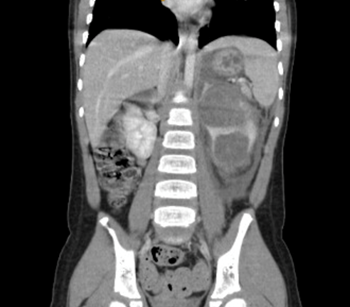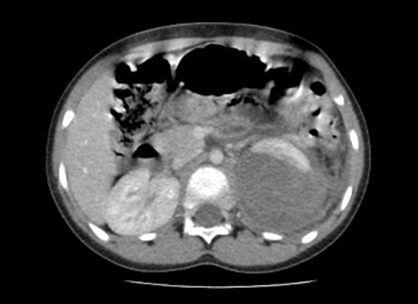What's the Diagnosis?
February 2022
Visual Diagnosis

Author: Ronald Palmen, MD | Internal Medicine – Pediatrics Resident, PGY-2
Column Editor: Joe Julian, MD, MPHTM, FAAP | Hospitalist, Internal Medicine - Pediatrics | Clinical Associate Professor, Internal Medicine and Pediatrics, UMKC School of Medicine
A 5-year-old girl presents to the emergency department (ED) with a two-day history of abdominal pain and fevers. The pain started in her left flank and was associated with a fever of 103°F. She had decreased oral intake and was resistant to almost any movement, mainly leaning toward her right side. Mother reported the patient has a history of frequent urinary tract infections (last one more than six months ago). The patient denies any dysuria, urgency, hematuria or any other urinary symptoms. Family history is significant for a biologic sister with a solitary kidney and a paternal grandfather who died secondary to renal failure.
In the ED, she was found to be tachycardic with a pulse of 130, hypertensive with a blood pressure of 134/86, and febrile at 101.7°F. A physical exam revealed a soft but mildly distended abdomen with mild generalized tenderness and severe tenderness to light palpation of her left abdomen and flank.
Initial lab work revealed a C-reactive protein of 70 mg/dL (normal <1), hemoglobin of 11.2 x 103 cells/mcL (normal >11), and a leukocytosis of 22.56 x 103 cells/mcL with elevated band cells of 0.97. Urinalysis was notable for 1+ protein, 1+ ketones, 5-10 WBCs/HPF, and 10-20 squamous epithelial cells. A CT abdomen/pelvis was obtained and shown below.


What is the most likely diagnosis?
A. Pyelonephritis
B. Wilms’ tumor
C. Renal hemorrhage
D. Perinephric abscess
Answer: B. Wilms’ tumor
Wilms’ tumor (WT) is a common childhood malignancy, accounting for approximately 6%-7% of all childhood cancers. It occurs most often in children ages 2-5 years with common presenting symptoms of hypertension, fever, hematuria and abdominal pain. However, it may also present asymptomatically. WT may mimic other renal pathologies both clinically and radiologically, including malignancies, hemorrhage or abscess.
Pyelonephritis is concerning in this case with the fever, abdominal pain and previous urinary tract infections. It is unlikely to present with significant hypertension and a lack of urinary symptoms. CT imaging also suggests an alternative diagnosis.
Renal hemorrhage is extremely rare in the absence of trauma. This condition can occur in underlying malignancy or rupture of a hemorrhagic cyst but it is very rare. Typical symptoms of presentation include Lenk’s triad of flank pain, tenderness, and “symptoms of blood loss,” which include generalized fatigue, tachycardia, dizziness, and hypotension depending on the volume of blood loss.
Perinephric abscesses are relatively rare in children. Clinical suspicion must be high in children with prolonged fever, abdominal pain and a high CRP. This condition, however, is unlikely in this patient given the radiographic nature of the multilobular appearing mass, the absence of infection for over six months, and the lack of prolonged fever.
References:
- Malkan AD, Loh A, Bahrami A, et al. An approach to renal masses in pediatrics. Pediatrics. 2015;135(1):142-158.
- Chen CY, Kuo HT, Chang YJ, Wu KH, Yang WC, Wu HP. Clinical assessment of children with renal abscesses presenting to the pediatric emergency department. BMC Pediatr. 2016;6(1):189.
- Seminara C, Planells MC, Pogonza RE, Morales M; Colaboradores. Wilms tumor: 15 years of experience at a children's hospital in Córdoba, Argentina. Arch Argent Pediatr. 2019;117(4): 263-270.
- Zhang JQ, Fielding JR, Zou KH. Etiology of spontaneous perirenal hemorrhage: a meta-analysis. J Urol. 2002;167:1593-1596.

